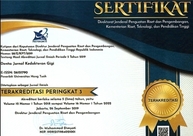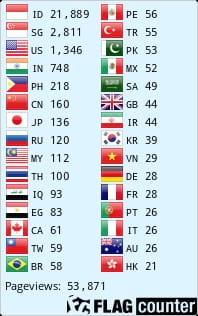The Effect of Kersen (Muntingia calabura L.) Leaf Extract Nanogel on Stomatitis
DOI:
https://doi.org/10.30649/denta.v16i1.8Keywords:
Kersen leaf, Nanoparticle, Collagen, Macrophage, RASAbstract
Background: Recurrent aphthous stomatitis (RAS) is common painful mucosal condition affecting the 5%-60% world’s population and become the third largest oral disease in Indonesia. Despite their high prevalence, RAS treatment is currently still dominated by the use of chemicals that scientifically have adverse side effects. Therefore, it is necessary to develop new approach using herbal product with no side effects. This literature review summarizes the potential of kersen leaf extract (Muntingia calabura L.), its dosage forms, and the possibility using nanotechnology that can speed up the drug delivery process. Objective: to determine the possibility effect of nanoparticle cherry leaf extract in gel form on decreasing number of macrophages and stimulating collagen in stomatitis. Methods: literature search using the PRISMA method with Science Direct, PubMed, Scielo, NCBI, Research gate, and Google Scholar databases of 1107 articles with keywords “Muntingia calabura L. leaves extract”, “nanogel”, “flavonoid”, “quercetin”, “fisetin”, “macrophage”, “collagen”, “soft tissue healing process” and “recurrent aphthous stomatitis”. The results of the literature selection found 22 articles. Results: flavonoids in cherry leaf extract can reduce the number of macrophages and increase collagen stimulation. The mechanism of action begins by inhibiting the production of pro-inflammatory cytokines, inhibiting macrophage migration and adhesion, stimulating the production of growth factors by macrophages for collagen synthesis, and decreasing collagenase. Nano gel form may increase retention time and drug penetration. Conclusion: Nanogel based cherry leaf extract may reduce the number of macrophages and stimulating collagen in minor RAS.
Downloads
References
Kementerian Kesehatan RI. Riset Kesehatan Dasar. Jakarta; 2014.
Kementerian Kesehatan RI. Riset Kesehatan Dasar. Jakarta; 2018.
Abdullah M. Prevalence of Recurrent Aphthous Ulceration Experience in Patients Attending Piramird Dental Speciality in Sulaimani City. Journal of Clinical and Experimental Dentistry. 2013. 89-94. Available from: https://doi.org/10.4317/jced.51042.
Ranganath SP, Pai A. Is Optimal Management of Recurrent Aphthous Stomatitis Possible? A Reality Check. Journal of Clinical and Diagnostic Research : JCDR. 2016; 10(10): 8-13. Available from: https://doi.org/10.7860/JCDR/2016/19519.8643
Bahramian A, Falsafi P, Abbasi T, Ghanizadeh M, Abedini M, Kavoosi F, et al. Comparing Serum and Salivary Levels of Vitamin D in Patients with Recurrent Aphthous Stomatitis and Healthy Individuals. Journal of Dentistry. 2018; 19(4): 295–300.
Chiang CP, Yu-Fong CJ, Wang YP, Wu YH, Wu YC, Sun A. Recurrent Aphthous Stomatitis – Etiology, Serum Autoantibodies, Anemia, Hematinic Deficiencies, and Management. Journal of the Formosan Medical Association. 2019; 118(9):1279–89. Available from: https://doi.org/10.1016/j.jfma.2018.10.023.
Ajmal M, Ibrahim L, Mohammed N, Al-Qarni H. Prevalence and Psychological Stress in Recurrent Aphthous Stomatitis among Female Dental Students in Saudi Arabia. Clujul Medical. 2018; 91(2): 216–21. Available from: https://doi.org/10.15386/cjmed-840.
Mehdipour M, Taghavi ZA., Sohrabi A, Gholizadeh N, Bahramian A, Jamali Z. A Comparison of the Effect of Triamcinolone Ointment and Mouthwash with or without Zinc on the Healing Process of Aphthous Stomatitis Lesions. Journal of Dental Research, Dental Clinics, Dental Prospects. 2016; 10(2): 87–91. Available from: https://doi.org/10.15171/joddd.2016.014.
Susanto H, Kendarwati P, Imanusti, K, Widyanigsih L, Budiarti S, Supriatno A. Decreased Salivary Cortisol in Recurrent Aphthous Stomatitis Treated with Topical Steroids. Journal of Islamic Dental Association of IRAN. 2019; 31(1): 26–32. Available from : https://doi.org/10.30699/jidai.31.1.5.
Wahba A, Farid M, Adawy H. A Comparative Study between the Combined Effect of Frankincense and Myrrh versus the Effect of Triamcinolone Acetonide on Healing of Induced Labial Mucosal Ulcer in Albino Rats. Al-Azhar Dental Journal for Girls. 2017; 4(4): 339–45. Available from: https://doi.org/10.21608/adjg.2017.5281.
Bakhshi M, Gholami S, Mahboubi, A, Jaafari MR, Namdari M. Combination Therapy with 1% Nanocurcumin Gel and 0.1% Triamcinolone Acetonide Mouth Rinse for Oral Lichen Planus: A Randomized Double-Blind Placebo Controlled Clinical Trial. Dermatology Research and Practice. 2020; 1–7. Available from: https://doi.org/10.1155/2020/4298193.
Rafieian N, Abdolsamadi H, Moghadamnia A, Jazayeri M, Seif-Rabiee M, Salmanzadeh M, et al. Efficacy of Alum for Treatment of Recurrent Aphthous Stomatitis. Caspian Journal of Internal Medicine. 2016; 7(3): 201–5.
Mahmood N, Nasir NLM, Rofiee MS, Tohid SFM, Ching SM, et al. Muntingiacalabura L: a Review on Its Traditional Uses, Chemical Properties and Pharmacological Observations. Pharm Biol. . 2014; 52: 1598–1623.
Niwele F, Sitepu PS, Simamora A, Timotius KH, Santoso AW. Nutritional Enzymes Inhibitory Activities of Fruit Juice and Fruit Pulp Extract of Muntingia Calabura L. Current Research in Nutrition and Food Science Journal. 2020; 8(3). Available from : https://www.foodandnutritionjournal.org/volume8number3/nutritional-enzymes-inhibitory-activities-of-fruit-juice-and-fruit-pulp-extract-of-muntingia-calabura-l-2/
Zakaria ZA, Balan T, Suppaiah V, Ahmad S, Jamaludin F. Mechanism(s) of Action Involved in the Gastroprotective Activity of Muntingia calabura. J Ethnopharmacol. 2014; 151:1184-93.
Rofiee MS, Yusof MIM, Abdul HEE, Bannur Z., Zakaria ZA, Somchit MN, The LK, Salleh MZ. Isolating the Metabolic Pathways Involved in the Hepatoprotective Effect of Muntingia calabura against CCl4-induced Liver Injury using LCMS Q-TOF. J Ethnopharmacol. 2015; 106: 109–18.
More S, Mohini U, Archana L, Sneha J. Comparative Quantification of Flavonoid Content and Antioxidant Potential of Indigenous Medicinal Plants. Journal of Pharmacognosy and Phytochemistry. 2018; 7(1): 343-45. Available from : http://www.phytojournal.com/archives/2018/vol7issue1/PartE/6-6-296-434.pdf.
Prayitno SA, Rahim AR. Comparison of Extracts (Ethanol And Aquos Solvents) Muntingia calabura Leaves on Total Phenol, Flavonid and Antioxidant (Ic50) Properties. Kontribusia (Research Dissemination for Community Development). 2020;3(2):319–25. Available from: https://doi.org/10.30587/kontribusia.v3i2.1451.
Halim SZ, Zakaria ZA, Omar MH, Mohtarrudin N, Wahab IRA, Abdullah MNH. Synergistic Gastroprotective Activity of Methanolic Extract of a Mixture of Melastoma malabathricum and Muntingia calabura Leaves in Rats. BMC Complementary and Alternative Medicine. 2017;17. Available from: https://doi.org/10.1186/s12906-017-1992-9.
Mandić L, Sadžak A, Strasser V, Baranović G, Domazet JD, Dutour SM, Šegota S. Enhanced Protection of Biological Membranes during Lipid Peroxidation: Study of the Interactions between Flavonoid Loaded Mesoporous Silica Nanoparticles and Model Cell Membranes. International Journal of Molecular Sciences. 2019; 20(11): 2709. Available from: https://doi.org/10.3390/ijms20112709.
Sims KR, He B, Koo H, Benoit DS W. Electrostatic Interactions Enable Nanoparticle Delivery of the Flavonoid Myricetin. ACS Omega. 2020; 5(22): 12649–59. Available from: https://doi.org/10.1021/acsomega.9b04101.
Kitchenham B. Procedures for Performing Systematic Reviews. Eversleigh: Keele University; 2004.
Boren SA, David M. Systematically Reviewing the Literature: Building the Evidence for Health Care Quality. Science of Medicine (Health Management and Informatics) . 2015; 112(1): 58-62.
Pandya M, Kalappanavar AN, Annigeri RG, Rao DS. Relative Efficacy of Quercetin Compared with Benzydamine Hydrochloride in Minor Aphthae: A Prospective, Parallel, Double Blind, Active Control, Preliminary Study. International Journal of Dentistry. 2017: 1-6. Available from: https://doi.org/10.1155/2017/7034390.
Pertiwi RD, Suwaldi, Martien R, Setyowati EP. Radical Scavenging Activity and Quercetin Content of Muntingia calabura L. Leaves Extracted by Various Ethanol Concentration. Journal of Food and Pharmaceutical Sciences. 2020; 8(1): 174-84. Available from: https://doi.org/10.22146/jfps.581.
Sari AS, Mellya E, Nasir MM, Muhammad RAR. Identification of Active Compounds on Muntingia calabura L. Leaves Using Different Polarity Solvents. Indonesian Journal of Chemical Science and Technology. 2020; 3(1): 1-7.
Desrini S, Mashita AI, Rosary AN, Hidayah UN, Farm S. Antibacterial Activity Screening of Muntingia Calabura L. Leaves Methanol Extract on Three Bacterial Pathogens. Pharmacologyonline. 2018; 11(2): 1-10. Available from: https://www.researchgate.net/publication/327570126_Antibacterial_activity_screening_of_Muntingia_Calabura_L_leaves_methano_extract_on_three_bacterial_pathogens.
Zakaria ZA, Sani MHM, Cheema MS, Kader AA, Kek TL, Salleh MZ. Antinociceptive Activity of Methanolic Extract of Muntingia calabura Leaves: Further Elucidation of The Possible Mechanisms. BMC Complementary and Alternative Medicine. 2014; 14: 63. Available from: https://doi.org/10.1186/1472-6882-14-63.
Setyadewi CM, Suzery M, Agustina LNA, Bambang C. The Comparison of Spectrophotometric and TLC-Densitometric for DPPH Radical Scavenging Activity Analysis of Three Medicinal Plant Extracts. Jurnal Kimia dan Pendidikan Kimia. 2020; 5(2): 110-122.
Quagliariello V, Iaffaioli RV, Armenia E, Clemente O, Barbarisi, M, Nasti G, et al. Hyaluronic Acid Nanohydrogel Loaded With Quercetin Alone or in Combination to a Macrolide Derivative of Rapamycin RAD001 (Everolimus) as a New Treatment for Hormone-Responsive Human Breast Cancer. Journal of Cellular Physiology. 2017; 232(8): 2063–74. Available from: https://doi.org/10.1002/jcp.25587
Roodbordeii F, Afshar M, Haji ATF, Choopani S, Torkaman G, Moayer F, Salimi M. Topical Hydrogel Containing Fumaria vaillantii Loisel. Extract Enhances Wound Healing in Rats. BMC Complementary and Alternative Medicine. 2019; 19(254): 1-9. Available from: https://doi.org/10.1186/s12906-019-2645-y.
Karavana SY, Gökçe EH, Rençber S, Özbal S, Pekçetin Ç, Güneri P, et al. A New Approach to The Treatment of Recurrent Aphthous Stomatitis with Bioadhesive Gels Containing Cyclosporine A Solid Lipid Nanoparticles: In Vivo/In Vitro Examinations. International Journal of Nanomedicine. 2012; 7: 5693–704. Available from: https://doi.org/10.2147/IJN.S36883.
Gavanji S, Larki B, Bakhtari A. The effect of extract of Punica granatum var. Pleniflora for Treatment of Minor Recurrent Aphthous Stomatitis. Integrative Medicine Research. 2014; 3(2): 83–90. Available from: https://doi.org/10.1016/j.imr.2014.03.001.
Zaccaria V, Curti V, Di Lorenzo A, Baldi A, Maccario C, Sommatis S, et al. Effect of Green and Brown Propolis Extracts on the Expression Levels of microRNAs, mRNAs and Proteins, Related to Oxidative Stress and Inflammation. Nutrients. 2017;9(10). Available from: https://doi.org/10.3390/nu9101090.
Nguyen C, Thao D. Wound Healing Activity of Crassocephalum crepidioides (Benth.) S. Moore. Leaf Hydroethanolic Extract. Oxidative Medicine and Cellular Longevity, 2020. 2020; 1–10. Available from: https://doi.org/10.1155/2020/2483187.
Kim JH, Kim MY, Kim JH, Cho JY. Fisetin Suppresses Macrophage-Mediated Inflammatory Responses by Blockade of Src and Syk. Biomolecules & Therapeutics. 2015; 23(5): 414–20. Available from: https://doi.org/10.4062/biomolther.2015.036.
Jin Y, Lin X, Song L, Liu M, Zhang Y, Qi X, Zhao D. The Effect of Pudilan Anti-Inflammatory Oral Liquid on the Treatment of Mild Recurrent Aphthous Ulcers. Evidence-Based Complementary and Alternative Medicine : ECAM. 2017: 1-6. Available from: https://doi.org/10.1155/2017/6250892.
Machado JL, Assunção AKM, da Silva MCP, Dos RAS, Costa GC, Arruda D, et al. Brazilian Green Propolis: Anti-Inflammatory Property by An Immunomodulatory Activity. Evidence-Based Complementary and Alternative Medicine: ECAM. 2012: 157652. Available from: https://doi.org/10.1155/2012/157652.
Cui S, Wu Q, Wang J, Li M, Qian J, Li S. Quercetin Inhibits LPS-Induced Macrophage Migration by Suppressing The iNOS/FAK/paxillin Pathway and Modulating The Cytoskeleton. Cell Adhesion & Migration. 2018; 13(1): 1–12. Available from: https://doi.org/10.1080/19336918.2018.1486142.
Permatasari DA, Karliana D, Iskandarsyah I, Arsianti A, Bahtiar, A. Quercetin Prevent Proteoglycan Destruction by Inhibits Matrix Metalloproteinase-9, Matrix Metalloproteinase-13, A Disintegrin and Metalloproteinase with Thrombospondin Motifs-5 Expressions on Osteoarthritis Model Rats. Journal of Advanced Pharmaceutical Technology & Research. 2019; 10(1): 2–8. Available from: https://doi.org/10.4103/japtr.JAPTR_331_18.
Rhimi W, Hlel R, Ben SI, Boulila A, Rejeb A, Saidi M. Dittrichia viscosa L. Ethanolic Extract Based Ointment with Antiradical, Antioxidant, and Healing Wound Activities. BioMed Research International. 2019: 1-10. Available from: https://doi.org/10.1155/2019/4081253.
Ernawati DS, Puspa A. Expression of Vascular Endothelial Growth Factor and Matrix Metalloproteinase-9 in Apis mellifera Lawang Propolis Extract Gel-Treated Traumatic Ulcers in Diabetic Rats. Veterinary World. 2018 11(3): 304–9. Availale from: https://doi.org/10.14202/vetworld.2018.304-309.
Krishnappa P, Venkatarangaiah K, Venkatesh, Shimoga RSK, Kayattukandy BR. Wound healing activity of Delonix elata Stem Bark Extract and Its Isolated Constituent Quercetin-3-rhamnopyranosyl-(1-6) Glucopyranoside in Rats. Journal of Pharmaceutical Analysis. 2016; 6(6): 389–95. Available from: https://doi.org/10.1016/j.jpha.2016.05.001.
Albaayit SFA, Abba Y, Rasedee A, Abdullah N. Effect of Clausena excavata Burm. F. (Rutaceae) Leaf Extract on Wound Healing and Antioxidant Activity in Rats. Drug Design, Development and Therapy. 2105; 9: 3507–351.
Downloads
Published
How to Cite
Issue
Section
License
Copyright (c) 2022 DENTA

This work is licensed under a Creative Commons Attribution-NonCommercial-ShareAlike 4.0 International License.
Dengan menggunakan Hak Lisensi (sebagaimana didefinisikan di bawah), Anda menerima dan setuju untuk terikat oleh syarat dan ketentuan Lisensi Publik Internasional Creative Commons Atribusi-BerbagiSerupa 4.0 ini ("Lisensi Publik"). Sejauh Lisensi Publik ini dapat diartikan sebagai suatu kontrak, Anda diberikan Hak Lisensi dengan mempertimbangkan penerimaan Anda terhadap syarat dan ketentuan ini, dan Pemberi Lisensi memberikan Anda hak tersebut dengan mempertimbangkan manfaat yang diterima Pemberi Lisensi dari penyediaan Materi Berlisensi berdasarkan syarat dan ketentuan ini.
Bagian 1 – Definisi.
- Materi Adaptasi berarti materi yang tunduk pada Hak Cipta dan Hak Serupa yang berasal dari atau berdasarkan Materi Berlisensi dan di mana Materi Berlisensi tersebut diterjemahkan, diubah, disusun, ditransformasi, atau dimodifikasi dengan cara lain yang memerlukan izin berdasarkan Hak Cipta dan Hak Serupa yang dimiliki oleh Pemberi Lisensi. Untuk tujuan Lisensi Publik ini, jika Materi Berlisensi berupa karya musik, pertunjukan, atau rekaman suara, Materi Adaptasi selalu diproduksi di mana Materi Berlisensi tersebut disinkronkan dalam hubungan waktu dengan gambar bergerak.
- Lisensi Adaptor berarti lisensi yang Anda terapkan pada Hak Cipta dan Hak Serupa dalam kontribusi Anda pada Materi Adaptasi sesuai dengan syarat dan ketentuan Lisensi Publik ini.
- Lisensi Kompatibel BY-SA berarti lisensi yang tercantum di creativecommons.org/compatiblelicenses , yang disetujui oleh Creative Commons sebagai padanan hakiki dari Lisensi Publik ini.
- Hak Cipta dan Hak Serupa berarti hak cipta dan/atau hak serupa yang berkaitan erat dengan hak cipta, termasuk, namun tidak terbatas pada, hak pertunjukan, hak siaran, hak rekaman suara, dan Hak Basis Data Sui Generis, tanpa memperhatikan bagaimana hak tersebut diberi label atau dikategorikan. Untuk tujuan Lisensi Publik ini, hak-hak yang disebutkan dalam Pasal 2(b)(1)-(2) bukan merupakan Hak Cipta dan Hak Serupa.
- Langkah-Langkah Teknologi yang Efektif berarti langkah-langkah yang, jika tidak ada kewenangan yang tepat, tidak dapat dielakkan berdasarkan hukum yang memenuhi kewajiban berdasarkan Pasal 11 Perjanjian Hak Cipta WIPO yang diadopsi pada tanggal 20 Desember 1996, dan/atau perjanjian internasional serupa.
- Pengecualian dan Batasan berarti penggunaan wajar, perlakuan wajar, dan/atau pengecualian atau batasan lain terhadap Hak Cipta dan Hak Serupa yang berlaku untuk penggunaan Anda atas Materi Berlisensi.
- Elemen Lisensi berarti atribut lisensi yang tercantum dalam nama Lisensi Publik Creative Commons. Elemen Lisensi dari Lisensi Publik ini adalah Atribusi dan Berbagi Serupa.
- Materi Berlisensi berarti karya seni atau sastra, basis data, atau materi lain yang kepadanya Pemberi Lisensi menerapkan Lisensi Publik ini.
- Hak Berlisensi berarti hak yang diberikan kepada Anda sesuai dengan syarat dan ketentuan Lisensi Publik ini, yang terbatas pada semua Hak Cipta dan Hak Serupa yang berlaku untuk penggunaan Anda atas Materi Berlisensi dan yang Pemberi Lisensi berwenang untuk melisensikannya.
- Pemberi lisensi berarti individu atau badan yang memberikan hak berdasarkan Lisensi Publik ini.
- Berbagi berarti menyediakan materi kepada publik melalui cara atau proses apa pun yang memerlukan izin berdasarkan Hak Lisensi, seperti reproduksi, tampilan publik, pertunjukan publik, distribusi, penyebaran, komunikasi, atau impor, dan menyediakan materi kepada publik termasuk dengan cara yang memungkinkan anggota publik mengakses materi tersebut dari suatu tempat dan pada waktu yang mereka pilih sendiri.
- Hak Basis Data Sui Generis berarti hak-hak selain hak cipta yang timbul dari Direktif 96/9/EC Parlemen Eropa dan Dewan tanggal 11 Maret 1996 tentang perlindungan hukum basis data, sebagaimana telah diubah dan/atau digantikan, serta hak-hak lain yang pada hakikatnya setara di mana pun di dunia.
- Anda berarti individu atau entitas yang menjalankan Hak Lisensi berdasarkan Lisensi Publik ini. "Anda" memiliki arti yang sesuai.
Bagian 2 – Ruang Lingkup.
- Pemberian lisensi .
- Tunduk pada syarat dan ketentuan Lisensi Publik ini, Pemberi Lisensi dengan ini memberikan Anda lisensi yang berlaku di seluruh dunia, bebas royalti, tidak dapat disublisensikan, tidak eksklusif, dan tidak dapat dibatalkan untuk melaksanakan Hak Lisensi dalam Materi Berlisensi untuk:
- memperbanyak dan Membagikan Materi Berlisensi, secara keseluruhan atau sebagian; dan
- memproduksi, memperbanyak, dan Berbagi Materi yang Diadaptasi.
- Exceptions and Limitations. For the avoidance of doubt, where Exceptions and Limitations apply to Your use, this Public License does not apply, and You do not need to comply with its terms and conditions.
- Term. The term of this Public License is specified in Section 6(a).
- Media and formats; technical modifications allowed. The Licensor authorizes You to exercise the Licensed Rights in all media and formats whether now known or hereafter created, and to make technical modifications necessary to do so. The Licensor waives and/or agrees not to assert any right or authority to forbid You from making technical modifications necessary to exercise the Licensed Rights, including technical modifications necessary to circumvent Effective Technological Measures. For purposes of this Public License, simply making modifications authorized by this Section 2(a)(4) never produces Adapted Material.
- Downstream recipients.
- Offer from the Licensor – Licensed Material. Every recipient of the Licensed Material automatically receives an offer from the Licensor to exercise the Licensed Rights under the terms and conditions of this Public License.
- Additional offer from the Licensor – Adapted Material. Every recipient of Adapted Material from You automatically receives an offer from the Licensor to exercise the Licensed Rights in the Adapted Material under the conditions of the Adapter’s License You apply.
- No downstream restrictions. You may not offer or impose any additional or different terms or conditions on, or apply any Effective Technological Measures to, the Licensed Material if doing so restricts exercise of the Licensed Rights by any recipient of the Licensed Material.
- No endorsement. Nothing in this Public License constitutes or may be construed as permission to assert or imply that You are, or that Your use of the Licensed Material is, connected with, or sponsored, endorsed, or granted official status by, the Licensor or others designated to receive attribution as provided in Section 3(a)(1)(A)(i).
- Tunduk pada syarat dan ketentuan Lisensi Publik ini, Pemberi Lisensi dengan ini memberikan Anda lisensi yang berlaku di seluruh dunia, bebas royalti, tidak dapat disublisensikan, tidak eksklusif, dan tidak dapat dibatalkan untuk melaksanakan Hak Lisensi dalam Materi Berlisensi untuk:
-
Other rights.
- Moral rights, such as the right of integrity, are not licensed under this Public License, nor are publicity, privacy, and/or other similar personality rights; however, to the extent possible, the Licensor waives and/or agrees not to assert any such rights held by the Licensor to the limited extent necessary to allow You to exercise the Licensed Rights, but not otherwise.
- Patent and trademark rights are not licensed under this Public License.
- To the extent possible, the Licensor waives any right to collect royalties from You for the exercise of the Licensed Rights, whether directly or through a collecting society under any voluntary or waivable statutory or compulsory licensing scheme. In all other cases the Licensor expressly reserves any right to collect such royalties.
Section 3 – License Conditions.
Your exercise of the Licensed Rights is expressly made subject to the following conditions.
-
Attribution.
-
If You Share the Licensed Material (including in modified form), You must:
- retain the following if it is supplied by the Licensor with the Licensed Material:
- identification of the creator(s) of the Licensed Material and any others designated to receive attribution, in any reasonable manner requested by the Licensor (including by pseudonym if designated);
- a copyright notice;
- a notice that refers to this Public License;
- a notice that refers to the disclaimer of warranties;
- a URI or hyperlink to the Licensed Material to the extent reasonably practicable;
- indicate if You modified the Licensed Material and retain an indication of any previous modifications; and
- indicate the Licensed Material is licensed under this Public License, and include the text of, or the URI or hyperlink to, this Public License.
- retain the following if it is supplied by the Licensor with the Licensed Material:
- You may satisfy the conditions in Section 3(a)(1) in any reasonable manner based on the medium, means, and context in which You Share the Licensed Material. For example, it may be reasonable to satisfy the conditions by providing a URI or hyperlink to a resource that includes the required information.
- If requested by the Licensor, You must remove any of the information required by Section 3(a)(1)(A) to the extent reasonably practicable.
-
- ShareAlike.
In addition to the conditions in Section 3(a), if You Share Adapted Material You produce, the following conditions also apply.
- The Adapter’s License You apply must be a Creative Commons license with the same License Elements, this version or later, or a BY-SA Compatible License.
- You must include the text of, or the URI or hyperlink to, the Adapter's License You apply. You may satisfy this condition in any reasonable manner based on the medium, means, and context in which You Share Adapted Material.
- You may not offer or impose any additional or different terms or conditions on, or apply any Effective Technological Measures to, Adapted Material that restrict exercise of the rights granted under the Adapter's License You apply.
Section 4 – Sui Generis Database Rights.
Where the Licensed Rights include Sui Generis Database Rights that apply to Your use of the Licensed Material:
- for the avoidance of doubt, Section 2(a)(1) grants You the right to extract, reuse, reproduce, and Share all or a substantial portion of the contents of the database;
- if You include all or a substantial portion of the database contents in a database in which You have Sui Generis Database Rights, then the database in which You have Sui Generis Database Rights (but not its individual contents) is Adapted Material, including for purposes of Section 3(b); and
- You must comply with the conditions in Section 3(a) if You Share all or a substantial portion of the contents of the database.
For the avoidance of doubt, this Section 4 supplements and does not replace Your obligations under this Public License where the Licensed Rights include other Copyright and Similar Rights.
Section 5 – Disclaimer of Warranties and Limitation of Liability.
- Unless otherwise separately undertaken by the Licensor, to the extent possible, the Licensor offers the Licensed Material as-is and as-available, and makes no representations or warranties of any kind concerning the Licensed Material, whether express, implied, statutory, or other. This includes, without limitation, warranties of title, merchantability, fitness for a particular purpose, non-infringement, absence of latent or other defects, accuracy, or the presence or absence of errors, whether or not known or discoverable. Where disclaimers of warranties are not allowed in full or in part, this disclaimer may not apply to You.
- To the extent possible, in no event will the Licensor be liable to You on any legal theory (including, without limitation, negligence) or otherwise for any direct, special, indirect, incidental, consequential, punitive, exemplary, or other losses, costs, expenses, or damages arising out of this Public License or use of the Licensed Material, even if the Licensor has been advised of the possibility of such losses, costs, expenses, or damages. Where a limitation of liability is not allowed in full or in part, this limitation may not apply to You.
- The disclaimer of warranties and limitation of liability provided above shall be interpreted in a manner that, to the extent possible, most closely approximates an absolute disclaimer and waiver of all liability.
Section 6 – Term and Termination.
- This Public License applies for the term of the Copyright and Similar Rights licensed here. However, if You fail to comply with this Public License, then Your rights under this Public License terminate automatically.
-
Where Your right to use the Licensed Material has terminated under Section 6(a), it reinstates:
- automatically as of the date the violation is cured, provided it is cured within 30 days of Your discovery of the violation; or
- upon express reinstatement by the Licensor.
- For the avoidance of doubt, the Licensor may also offer the Licensed Material under separate terms or conditions or stop distributing the Licensed Material at any time; however, doing so will not terminate this Public License.
- Sections 1, 5, 6, 7, and 8 survive termination of this Public License.
Bagian 7 – Syarat dan Ketentuan Lainnya.
- Pemberi Lisensi tidak akan terikat oleh ketentuan atau persyaratan tambahan atau berbeda yang dikomunikasikan oleh Anda kecuali disetujui secara tegas.
- Segala pengaturan, kesepahaman, atau perjanjian mengenai Materi Berlisensi yang tidak dinyatakan di sini terpisah dari dan independen dari syarat dan ketentuan Lisensi Publik ini.
Bagian 8 – Interpretasi.
- Untuk menghindari keraguan, Lisensi Publik ini tidak, dan tidak akan ditafsirkan untuk, mengurangi, membatasi, mengekang, atau memaksakan ketentuan pada penggunaan Materi Berlisensi yang secara sah dapat dilakukan tanpa izin berdasarkan Lisensi Publik ini.
- Sedapat mungkin, jika ada ketentuan dalam Lisensi Publik ini yang dianggap tidak dapat diberlakukan, ketentuan tersebut akan secara otomatis direformasi hingga batas minimum yang diperlukan agar dapat diberlakukan. Jika ketentuan tersebut tidak dapat direformasi, ketentuan tersebut akan dihapus dari Lisensi Publik ini tanpa memengaruhi keberlakuan syarat dan ketentuan lainnya.
- Tidak ada syarat atau ketentuan Lisensi Publik ini yang akan diabaikan dan tidak ada kegagalan untuk mematuhi yang disetujui kecuali disetujui secara tegas oleh Pemberi Lisensi.
- Tidak ada satu pun dalam Lisensi Publik ini yang merupakan atau boleh ditafsirkan sebagai pembatasan atau pengesampingan hak istimewa dan kekebalan apa pun yang berlaku bagi Pemberi Lisensi atau Anda, termasuk dari proses hukum di yurisdiksi atau otoritas mana pun.











